![]()
![]()
Harris 1980.
Harris 1980, (Age 16yrs 0m - 17yrs 11m) 07/08/1980 - 28/08/1980
LEADER: Jonathan Orr
A/Ls: Jeremy Biggs, Andy Brettell, Peter Fale, Ray Snook, Chris Venning.
MEMBERS: Andrew Bartle, Neil Bell. Timothy Bennett, Stephen Collins, Andrew Cotton, Andrew Fale,
Gael Gerragu, Paul Garnett. Simon Lorimer, Peter Miles, Justin Pitcher, Richard Pitts, Mitchell Stubley,
Simon Watson, Andrew Westmacott, Paul Williamaon, Richard Yound.
All photos on this page are thanks to Simon Lorimer who spent his weekend scanning a few hundred photos.
|
LEADER'S REPORT Normally when the S.H.S goes to the islands every effort is made to lessen the impact on the community in the area, so it was with some surprise that I realised the expedition was to camp within a village. From the outset the expedition to Rhenigidale presented an interesting set of logistic problems but thankfully by 7th August most had been resolved, primarily because of Jim Turner's hard work with the travel. The train journey up from Euston had two faults: double reservations at both the front and back of the train and in addition a heart-stopping 1˝ hour delay on the single track section into Fort William. Chaos was averted by the MacBraynes Mallaig to Armadale service running one hour late and the helpful faces of the entire Knoydart expedition on the quay with all the kit ready in cages. We stayed the night on Skye at the campsite in Uig and caught the ferry to Tarbert the following morning. The evening was spent playing the Skyelanders at football ("Scotland versus England"). Regrettably the score was 7-1, but it was a good chance for the expedition to get to know each other and be introduced to the midge. In Tarbert the 'Margaret Rae’ lobster boat was waiting to load the equipment and take it around to the village. It was this journey that provoked the words of the song "Oh you'll never get to heaven on the Margaret Rae ... because you’ll-get drunk on the way". The bulk of the expedition walked overland (the "breath taking" path) and arrived just ahead of the boat which zigzagged its way into the bay at Rhenigidale. |
|
|
|
|
|
Despite 14 of the 17 expedition members being new to the society the camp was quickly set up and functioning smoothly - due mainly to the tireless efforts of Ray Snook the CA. The marquee perched pimple-like on the only flat ground, a ridge 30 feet from the shore. It was to survive all the winds except one. (The three rips in the sidewalls will presumably mean it is another 10 years before we again hire from Blacks). To those in the society who don't know Rhenigidale - it is the last village in Britain without electricity or a road. Halfway through our stay the BBC News at Nine team arrived after approval for the new road was announced. The village has 10 inhabitants including the teacher and the only pupil. They are all most charming, friendly and helpful (which makes me wonder whether I would be - if 25 thugs pitched a marquee 40 feet from my back door). The expedition was made to feel part of the community during its stay and was given introductions throughout the island. The end of the first week was brightened by the arrival of the Royal Yacht Britannia and H.M.S. Leander 2 km off-shore. H.M. was on her way to Balmoral and stopped for a break. (Shown right) |
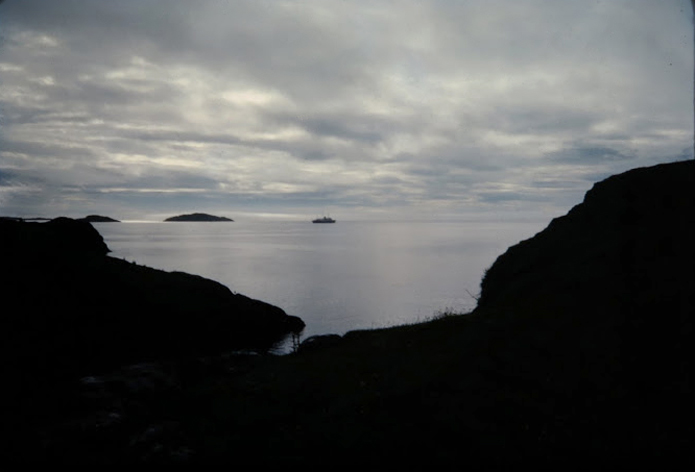 |
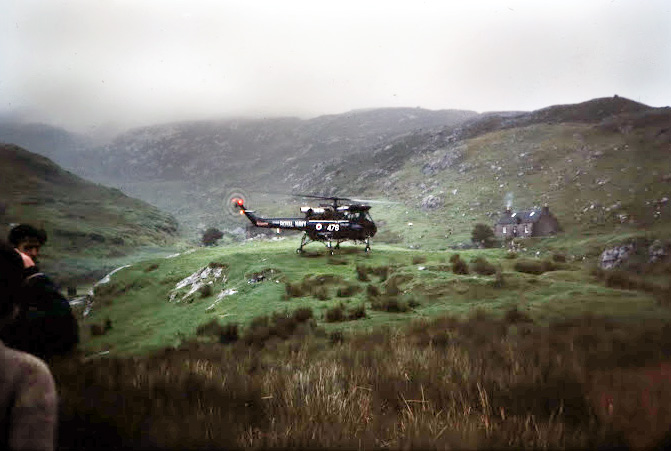 Helicopter from HMS Leander taking Paul off to hospital.
|
The first bivvy party had a major problem on its return in foul weather the next day -Paul Williamson's back gave-out on the approach path to the west of camp. Three hours after collapsing he was in Stornaway Hospital courtesy of the communications on the Britannia and the helicopter of the Leander. Luckily there was nothing very seriously amiss and Paul rejoined the expedition a week later. Climbing on the trip had a slow start because of: the weather, wet rock, midges and Chris Venning, the climbing A/L. having a monumental dose of the Rhenigadale-runs. Towards the end of the stay good use was made of the excellent local rock and as a finale the climbers put a fence for the villagers on a hair raising cliff-face. The canoeing bivvy was replaced by a trip to the Shiant islands -the offer to help the shepherds was too good to miss and also regrettably two of the four canoes had given up the ghost. The P4 inflatable worked endlessly ferrying parties to the path in the west and up Loch Seaforth to the north. The home-made lobster-pot failed to attract shellfish despite being sunk in the channel five feet two deep for its float line. Luckily it was retrieved at the neap tide two days before our departure. Six bivvies were undertaken to the west coast of North Harris, to Maarig (to play bridge), to the Shiants (to shear sheep), to Scalpay (only to find there was no pub), to South Harris (Toe Head) and "Up Toddun" - the local hill (to see the sun rise). It was an expedition of activity rather than projects but useful work was undertaken on Lichens and the birdwatchers worked very hard, especially in the vicinity of the youth hostel. The memory I most come away with is how welcome we were all made to feel - which reflects on the previous expeditions. Hopefully the work which we did in the village in helping to build Kenny’s home extension will lay a similar foundation for those who follow. I would go again tomorrow.
|
|
THE "SCALPAY" BIVVY Surely this must have been one of the most carefully planned bivvies of all time it being proposed in the first week of camp and executed in the final week-end. During this time a reconnoitre was held to spot a likely campsite and obtain ferry times, Scalpay being an island off Harris, east of Tarbet. The bivvy was held over one night and was attended by Ray Snook, Simon Lorimer, Neil Bell and myself. Our main purpose was to have a good nights sleep (i.e. on the level) as well as see some of Scalpay. We set off on the 22nd on a clear day and with the promise of good weather to come. Our route from Rhenigidale took us along the path to Tarbet as far as the cairn at the top of the zig-zags. We then headed along the ridge running south west to Uiseval where we ate dinner looking out over Scalpay below us. With this completed we headed down to Kyles Scalpay to catch the 2.35 ferry. From the pier on Scalpay we went straight to our campsite on a small peninsula on Loch AnDuin. Having pitched the tents on a level peat floor and had a cup of coffee we set out for the light house on the east coast of the island and taking in Ben Scoravic at 104 metres, Scalpay's highest peak. At the light house we were able to see main camp at Rhenigidale and after a careful look around the light house building we headed back to our camp site. Here the advantages of bivvying with the C.A. were realised as we ate half a sponge pudding each. Porridge and scrambled eggs were on the menu for breakfast and putting the scrambled eggs on, Neil took them off with his boot, so we set off for the ferry. After our one course breakfast. Our route home took us along the road from Kyles Scalpay via Urgha to Tarbet and the Macleod Motel!! After refreshment and a plate of chips we bounced home to Rhenigidale rested and with the feeling that Scalpay could easily have harboured a longer visit.
Simon's view from the tent in the morning |
Above: The Scalpay bivvy on Loch AnDuin (NG 227 963) Below: The bay at Rhenigidale |
|
Below, some more from the site at Rhenigidale |
|
|
Securing the tents for a storm? |
|
|
|
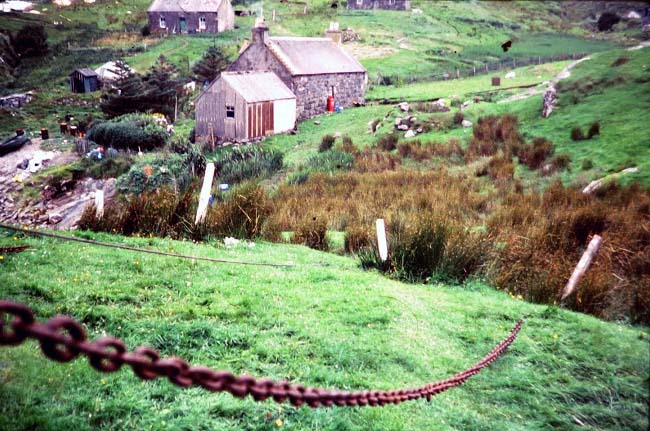 |
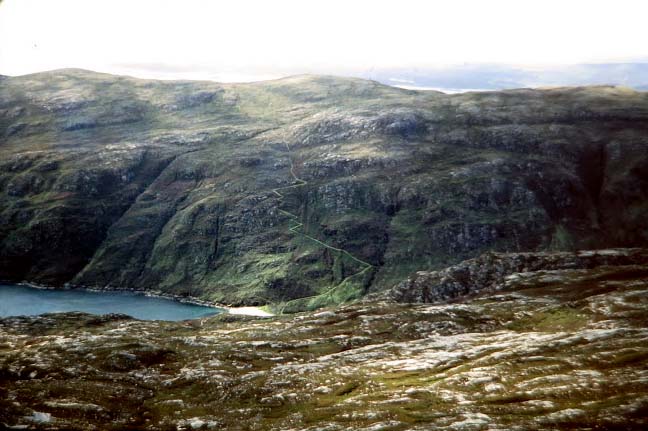 |
|
Some serious chains to hold down the marquee |
The "Breath taking" path zigzagging up the rock face. |
|
|
|
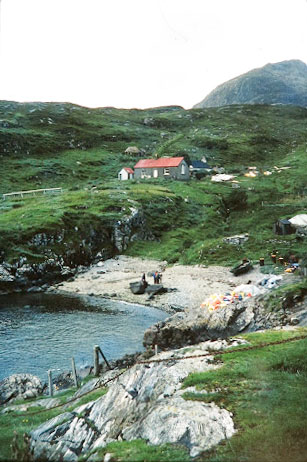 |
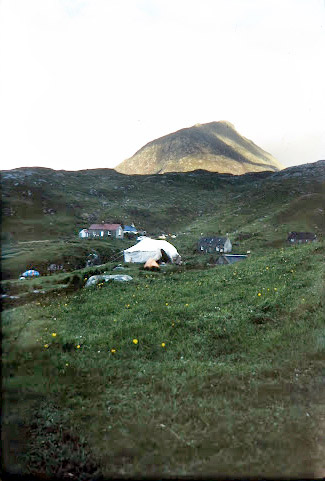 |
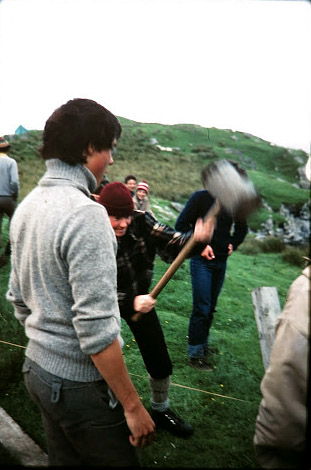 |
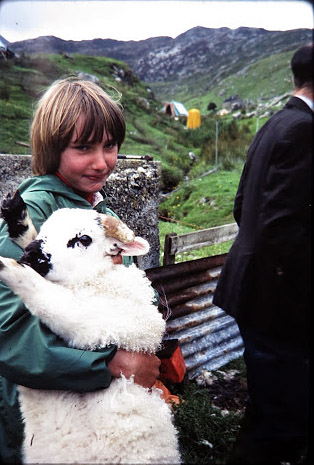 |
| Rhenigidale bay | Todunn behind Rhenigidale | Securing the marquee | Lunch? |